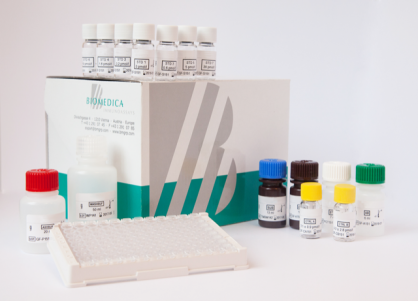VEGF ELISA Assay Kit
VEGF ELISA Assay Kit Developed and Manufactured in Austria by Biomedica
Size: 1×96 wells
Sensitivity: 2.5 pg/ml
Standard Range: 0 – 2000 pg/ml
Incubation Time: 4.5 hours
Sample Type: Serum, EDTA plasma, citrate plasma, cell culture supernatants, urine
Sample Size: 10 µl
Alternative Names: Vascular endothelial growth factor, VEGF-A, VEGFA, VPF, MVCD1, Vascular endothelial growth factor A, vascular endothelial growth factor A121, vascular endothelial growth factor A165, Vascular permeability factor, VEGF-A, VPF
For Research Use Only
Controls Included
Assay Principle
The human Vascular Endothelial Growth Factor (VEGF) ELISA kit is a sandwich enzyme immunoassay that has been optimized and fully validated for the quantitative determination of human VEGF in serum, EDTA plasma, and citrate plasma. Validation experiments have been performed according to international quality guidelines (ICH/ FDA/ EMEA). Cell culture supernatant and urine samples are compatible with this ELISA. The VEGF ELISA assay recognizes both natural and recombinant human VEGF. The assay employs highly purified epitope mapped antibodies as well as human serum-based standards and controls.
In a first step, assay buffer is pipetted into the wells of the microtiter strips. Thereafter, STD/ sample/CTRL are pipetted into the wells, which are pre-coated with the recombinant antihuman VEGF antibody. Any soluble VEGF present in the STD/sample/CTRL binds to the pre-coated anti-VEGF antibody in the well. After incubation, a washing step is applied where all non-specific unbound material is removed. In the next step, the biotinylated anti-VEGF antibody (AB) is pipetted into the wells and reacts with the VEGF present in the sample, forming a sandwich.
Next, all unbound antibody is removed during another washing step. In the following step, the conjugate (streptavidin-HRPO) is added and reacts with the biotinylated anti-VEGF antibody. After another washing step, the substrate (tetramethylbenzidine; TMB) is pipetted into the wells. The enzyme catalysed color change of the substrate is directly proportional to the amount of VEGF present in the sample. This color change is detectable with a standard microtiter plate ELISA reader.
A dose response curve of the absorbance (optical density, OD at 450 nm) versus standard concentration is generated, using the values obtained from the standards. The concentration of soluble VEGF in the sample is determined directly from the dose response curve.



